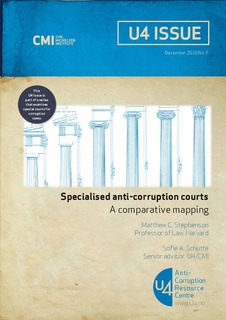Specialised anti-corruption courts: A comparative mapping
Original version
Bergen: Chr. Michelsen Institute (U4 Issue 2016:7) 28 pAbstract
Frustration with the capacity of the ordinary machinery of justice to deal adequately with corruption has prompted many countries to develop specialised anti-corruption institutions. While anti-corruption agencies with investigative and/or prosecutorial powers have attracted more attention, judicial specialisation is an increasingly common feature of national anti-corruption reform strategies. The most common argument for the creation of special anti-corruption courts is the need for greater efficiency in resolving corruption cases promptly and the associated need to signal to various domestic and international audiences that the country takes the fight against corruption seriously. In some countries, concerns about the ability of the ordinary courts to handle corruption cases impartially, and without being corrupted themselves, have also played an important role in the decision to create special anti-corruption courts. Existing specialised anti-corruption courts differ along a number of dimensions, including their size, their place in the judicial hierarchy, mechanisms for selection and removal of judges, the substantive scope of the courts? jurisdiction, trial and appellate procedures, and their relationship with anti-corruption prosecutors. These institutional design choices imply a number of difficult trade-offs: while there are no definitive ?best practices? for specialised anti-corruption courts, existing models and experience may provide some guidance to reformers considering similar institutions. They must decide whether such a court should adopt procedures that are substantially different from those of other criminal courts, and/or special provisions for the selection, removal, or working conditions of the anti-corruption court judges.
